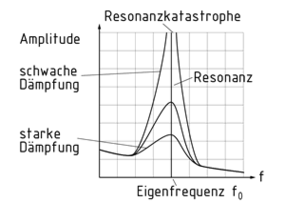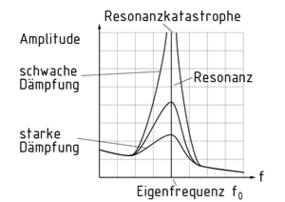
Seleccione uno
o más idiomas
0,1,3
- Alemán
- Inglés
- Chino
- Español
Resonancia

La resonancia es la covibración de un sistema oscilatorio. Si la frecuencia de excitación f está cerca de la frecuencia natural $F_{0}$ del sistema que está siendo excitado, esto resulta en resonancia. La amplitud de la vibración está en su punto máximo en el estado de resonancia. Es inversamente proporcional al amortiguamiento del sistema de vibración. El motivo de esto es que el amortiguamiento convierte la energía cinétic en energía térmica, lo que significa que hay menos energía disponible para la vibración que en un sistema sin amortiguamiento.
En el caso del bajo amortiguamiento, el sistema ya no podrá soportar los esfuerzos del aumento de resonancia por motivos relativos al material. La resultante de la catástrofe de resonancia destruye el sistema.
Amplitudes cerca de la frecuencia natural
Resonanz

Eine Resonanz ist das Mitschwingen eines schwingungsfähigen Systems. Liegt die Erregerfrequenz f nah an der Eigenfrequenz f0 des angeregten Systems, so gelangt es in Resonanz. Die Amplitude der Schwingung ist im Resonanzfall maximal. Ihre Größe fällt umgekehrt proportional zu der Dämpfung des schwingenden Systems aus. Ursache dafür ist, dass bei einer Dämpfung Kinetische Energie in Wärmeenergie umgewandelt wird und somit weniger Energie als bei einem ungedämpften System für die Schwingung zur Verfügung steht.
Bei einer geringen Dämpfung kann das System den Belastungen der sogenannten Resonanzüberhöhung aus werkstofftechnischen Gründen nicht mehr Stand halten. Es tritt eine Resonanzkatastrophe ein, durch die das System zerstört wird.
Resonance

Resonance is the covibration of an oscillatory system. If the excitation frequency f is close to the Natural frequency f0 of the system being excited, this results in resonance. The vibration amplitude is at a maximum in the resonant state. It is inversely proportional to the Damping of the vibrating system. The reason for this is that damping converts Kinetic energy into heat energy, which means that less energy is available for vibration than in an undamped system.
In the case of low damping, the system is no longer able to withstand the stresses of the resonance rise for material-related reasons. The resultant resonance catastrophe destroys the system.
共振

共振是振动系统中的振动现象。 如果激振频率 f接近系统的 固有频率 $F_{0}$ ,就会导致 共振现象。振幅 是指共振状态的最大值。振幅与系统的阻尼成反比例关系。这是因为阻尼将动能 转化为热能, 意味着相比于无阻尼系统,用于振动的能量变少。
在低阻尼情况下,出于材料本身的原因,系统无法承受由于 共振上升而产生的应力。随之而来的 共振突变 摧毁了整个系统。
振幅接近固有频率
